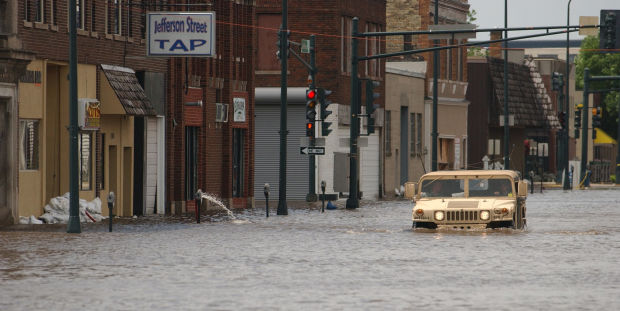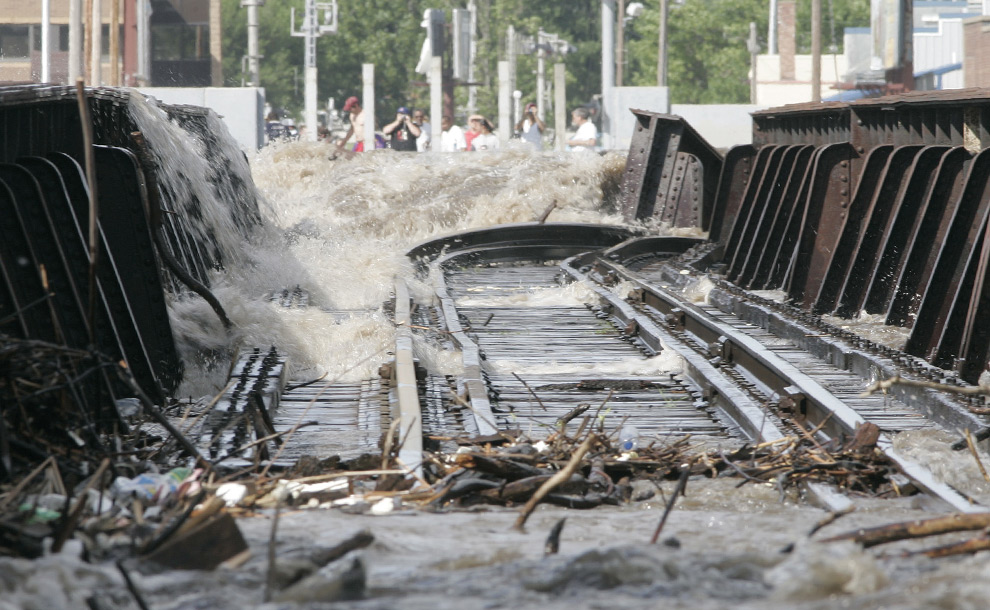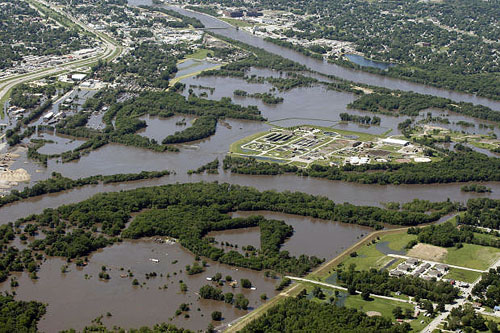The 2008 Flood in Waterloo
Waterloo, Black Hawk County, Iowa
Abigail Weaver
6/10/2008

(Dennis Magee/ Waterloo-Cedar Falls Courier)
2008 had already been a year for the record books, an EF 5 205 mph tornado had already torn through Black Hawk County in May, when residents of Waterloo were watching the Cedar River swell from the torrential rains that hit Northeast Iowa in June. Communities farther north in the Cedar River valley had already begun to experience historic levels of flooding as the residents of Waterloo frantically prepared their town for the coming flood waters. The National Weather Service would record the Cedar River reaching a record high crest of 25.39 feet in Waterloo, with a secondary crest reaching 21.9 feet.
The flooding reached downtown Waterloo on June 10, 2008, as the roads flooded with several inches to a few feet of water throughout the city. There had been two mandatory evacuations, and employees of the downtown businesses were sandbagging and attempting to locate pumps to empty water from the basements. The Waterloo-Cedar Falls Courier reported on June 12, 2008:Just days earlier, downtown Waterloo was its normal, bustling self. Shops were open, and people were milling around. Now, the power was out, businesses were closed and the only ones found wading through the increasingly higher waters were owners frantically sandbagging and hoping their pumps stayed ahead of water.
Joana Van Blaricom, owner of Kings and Queens, and Sapphire’s Gentlemen’s Club in Waterloo, said that “The National Guard told us it’s gonna get worse before it gets better.” Gene Leonhart, the president of Cardinal Construction, ran four pumps to try and keep his building clear of water but was losing the battle to the flood waters as storm sewers in the surrounding streets overflowed. He lamented that “If there was a levee break, we’d be in deep trouble.”
Local media was not spared the effects of the already historic flood waters as the newspapers, radio, and television stations fought to keep residents of Waterloo informed throughout the flood. On June 10, 2008 water poured into the basement of the Waterloo-Cedar Falls Courier printing facility, and the Wednesday edition of the newspaper was transferred to the Cedar Rapids Gazette’s building. The newspaper was produced on time but the flooded roads made delivery difficult.
Also on June 10th, local television station, KWWL, was off the air for more than three hours, after flood waters created an electrical outage, until a backup generator was located to power the station at 9:30 am. Three different radio stations, KCRR 97.7, KKHQ 92.3, and KOEL 98.5, all also lost power for three hours that same morning. The new Courier publisher, David Braton, who had been hired on April 1st described the experience as “a baptism by fire,” since the media had to find ways to keep functioning to provide crucial information.

(AP Photo/ The Waterloo Courier/ Morgan Hawthorne)
Another disaster occurred during the afternoon on June 10, 2008 as one third of a railroad bridge used by the Iowa Northern Railroad to transport John Deere tractors to Cedar Rapids was washed away at 2:45 pm. Roger Verch witnessed the bridge wash out and said “We were actually standing on the 18th Street Bridge downstream when it gave way. It struck the 18th Street Bridge. We really felt the vibrations.” A portion of the bridge remained caught in the 18th Street Bridge while the rest washed away down the river. Another man, Percy Burt, had been fishing near the railroad tracks when the incident occurred and said “The guy from the railroad said, ‘You better get down from there. It’s liable to go.’ The rails started popping and raised up. Everybody had to go.”
Meteorologists reported that in twenty-four hours Waterloo had received another half-inch of rain. On June 12, 2008 the National Weather Service reported that the Cedar River in Waterloo would not fall below the flood stage of twelve feet until Wednesday June 18. Residents of Waterloo were in a state of shock as an evacuation between the Cedar River and Jefferson Street was issued.
Curt Olmstead, a resident of Waterloo who had been evacuated from his home by boat, wasn’t surprised by the amount of water in Liberty Park, “If you get a hard rain it does fill up. I have seen it like this before, but I’ve never seen it where they had to sandbag it like that. It’s big. Everything is big.” Liberty Park and Bontrager Park were both sandbagged so that the land would collect water, serving as retention basins for the storm drains and sewers that had been inundated by more water than they could handle.
On June 13, 2008 the Waterloo-Cedar Falls Courier reported that Michael Chertoff, the U.S. Secretary of Homeland Security, met with city officials in Waterloo. Chertoff said “To a lay person’s eye, it certainly seems to meet that standard of a once-in-every-500-years flood. In terms of river flooding, this seems very substantial. Clearly there’s an awful impact in the communities along the river.” He believed that Waterloo would qualify for federal aid, both individual and public assistance, to help the communities recover.
William Gronen, who owned a house in Waterloo’s Chautaqua Park Neighborhood, had water five feet deep in his house on June 14, a shock since the house had only ever flooded once, in 1961. That same day Iowa’s governor Chet Culver, U.S. Senators Charles Grassley and Tom Harkin visited Waterloo to assure residents that they would lobby for Federal Emergency Management Agency (FEMA) aid to be offered quickly to residents of Iowa affected by the flooding.

(Matthew Putney/ Courier Photo Editor)
On June 15, 2008 the Waterloo-Cedar Falls Courier ran the headline “Lafayette Park Area Still Battles High Water,” as residents still dealt with feet of water in their basements. Deere and Co. lent Waterloo industrial pumps from out-of-state to help pump water from Lafayette Park to over the levee at the Cedar River.
Recovery from the flood finally began two days later with the Waterloo-Cedar Falls Courier reporting: “Waterloo Begins Restoring Public Services,” as the city began to start removing barricades and restored regular garbage collection as well as opening the landfills to help residents deal with flood debris.
The flood was officially over on June 18, 2008 when the water in the Cedar River finally fell below the flood stage. But the effect of the flood on Waterloo was huge; the Waterloo-Cedar Falls Courier ran an article, “Damage Estimate: $18 Million Just for City of Waterloo.” The flood waters had reached a record height of 26 feet on June 11th, and Mayor Tim Hurley of Waterloo estimated that the total damage in the city ranged from $14 million to $18 million. In December, readers of the Waterloo-Cedar Falls Courier voted the 2008 flooding in Waterloo and other areas one of the most memorable events of the year.
